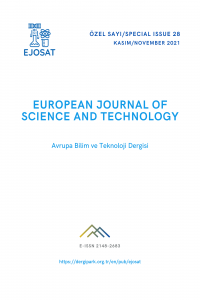Abstract
Geçmişten günümüze gelişen ve kullanımı giderek artan mobil cihazlar, bu artışla beraber mobil kablosuz iletişim teknolojilerinin de gelişimine öncülük etmiştir. Bu cihazların en temel özelliği olan taşınabilirlik, her ortamda kesintisiz olarak iletişime devam edebilmeleri için mobil iletişim teknolojilerinin gelişmesinde en büyük etkendir. Yıllar içinde gelişen ve büyük coğrafik alanlarda kablosuz iletişim servisleri sağlayan hücresel ağlar, artan cihaz sayısı ve talep edilen iletişim yükünü karşılayabilmek için süre gelen yıllarda birçok yeni jenerasyon (1G, 2G, 3G, 4G vb.) ağ teknolojisi ile bu alanda iletişim sağlayan en temel ağlardır. Bu çalışmada yeni ve eski model hücresel ağ teknolojilerinin gelişimi irdelenmiş ve yıllara göre büyüyen ağ şartlarındaki iyileşmeler araştırılmıştır. Ve bu bağlamda, gelecek nesil hücresel ağ teknolojilerinin tahmini ağ kapasiteleri hakkında bazı çalışmalar irdelenmiştir.
Supporting Institution
Noboyd
Project Number
-
References
- Cisco, U. (2020). “Cisco annual internet report (2018–2023)”,https://www.cisco.com/c/en/us/solutions/collateral/executive-perspectives/annual-internet-report/white-paper-c11-741490.html
- Yadav, R. (2017, March). “Challenges and evolution of next generations wireless communication.” In Proceedings of the International MultiConference of Engineers and Computer Scientists (Vol. 2).
- del Peral-Rosado, J. A., Raulefs, R., López-Salcedo, J. A., & Seco-Granados, G. (2017). “Survey of cellular mobile radio localization methods: From 1G to 5G.” IEEE Communications Surveys & Tutorials, 20(2), 1124-1148.
- Mondal, S., Sinha, A., & Routh, J. (2015). A survey on evolution of wireless generations 0G to 7G. International Journal of Advance Research in Science and Engineering (IJARSE), 1(2), 5-10.
- Gupta, A., & Jha, R. K. (2015). “A survey of 5G network: Architecture and emerging technologies.” IEEE access, 3, 1206-1232.
- Gohil, A., Modi, H., & Patel, S. K. (2013, March). 5G technology of mobile communication: A survey. In 2013 international conference on intelligent systems and signal processing (ISSP) (pp. 288-292). IEEE.
- Ezhilarasan, E., & Dinakaran, M. (2017, February). A Review on mobile technologies: 3G, 4G and 5G. In 2017 second international conference on recent trends and challenges in computational models (ICRTCCM) (pp. 369-373). IEEE.
- Agiwal, M., Roy, A., & Saxena, N. (2016). Next generation 5G wireless networks: A comprehensive survey. IEEE Communications Surveys & Tutorials, 18(3), 1617-1655.
- Habibi, M. A., Nasimi, M., Han, B., & Schotten, H. D. (2019). A comprehensive survey of RAN architectures toward 5G mobile communication system. IEEE Access, 7, 70371-70421.
- Mihret, E. T., & Haile, G. (2021). “4G, 5G, 6G, 7G and Future Mobile Technologies.” J Comp Sci Info Technol, 9(2), 75. Tidke, R. P., Uttarwar, P. S., Dandwate, D. S., & Tupe, U. J. (2020). A Literature Review On: Wireless Technologies From 0G to 7G.
- Shoewu, O. O., & Ayangbekun. (2020). Oluwafemi, J. Insights into the development trends in 7G mobile wireless networks.
Abstract
Mobile devices, which have developed from the past to the now and whose use is increasing, have also led the development of wireless communication technologies. Portability, which is the most basic feature of these devices, is the biggest factor in the development of mobile communication technologies so that these devices can maintain communication in any environment without interruption. Cellular networks, which have developed over the years and provide wireless communication services in large geographical areas, are the most basic networks that provide communication in this area with many new generation (1G, 2G, 3G, 4G etc.) network technologies in order to handle the increasing number of devices and the demanded communication load in the coming years. In this paper, the development of new and old model cellular network technologies has been examined and the improvements in network conditions that have grown over the years have been investigated. And in this context, some works on the estimated network capacities of next generation cellular network technologies are examined.
Project Number
-
References
- Cisco, U. (2020). “Cisco annual internet report (2018–2023)”,https://www.cisco.com/c/en/us/solutions/collateral/executive-perspectives/annual-internet-report/white-paper-c11-741490.html
- Yadav, R. (2017, March). “Challenges and evolution of next generations wireless communication.” In Proceedings of the International MultiConference of Engineers and Computer Scientists (Vol. 2).
- del Peral-Rosado, J. A., Raulefs, R., López-Salcedo, J. A., & Seco-Granados, G. (2017). “Survey of cellular mobile radio localization methods: From 1G to 5G.” IEEE Communications Surveys & Tutorials, 20(2), 1124-1148.
- Mondal, S., Sinha, A., & Routh, J. (2015). A survey on evolution of wireless generations 0G to 7G. International Journal of Advance Research in Science and Engineering (IJARSE), 1(2), 5-10.
- Gupta, A., & Jha, R. K. (2015). “A survey of 5G network: Architecture and emerging technologies.” IEEE access, 3, 1206-1232.
- Gohil, A., Modi, H., & Patel, S. K. (2013, March). 5G technology of mobile communication: A survey. In 2013 international conference on intelligent systems and signal processing (ISSP) (pp. 288-292). IEEE.
- Ezhilarasan, E., & Dinakaran, M. (2017, February). A Review on mobile technologies: 3G, 4G and 5G. In 2017 second international conference on recent trends and challenges in computational models (ICRTCCM) (pp. 369-373). IEEE.
- Agiwal, M., Roy, A., & Saxena, N. (2016). Next generation 5G wireless networks: A comprehensive survey. IEEE Communications Surveys & Tutorials, 18(3), 1617-1655.
- Habibi, M. A., Nasimi, M., Han, B., & Schotten, H. D. (2019). A comprehensive survey of RAN architectures toward 5G mobile communication system. IEEE Access, 7, 70371-70421.
- Mihret, E. T., & Haile, G. (2021). “4G, 5G, 6G, 7G and Future Mobile Technologies.” J Comp Sci Info Technol, 9(2), 75. Tidke, R. P., Uttarwar, P. S., Dandwate, D. S., & Tupe, U. J. (2020). A Literature Review On: Wireless Technologies From 0G to 7G.
- Shoewu, O. O., & Ayangbekun. (2020). Oluwafemi, J. Insights into the development trends in 7G mobile wireless networks.
Details
| Primary Language | Turkish |
|---|---|
| Subjects | Engineering |
| Journal Section | Articles |
| Authors | |
| Project Number | - |
| Publication Date | November 30, 2021 |
| Published in Issue | Year 2021 Issue: 28 |


